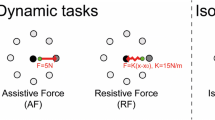Summary
EMG patterns associated with voluntary wrist flexion movements were studied in normal human subjects. Initially, subjects were trained to produce movements within five specified velocity ranges while the amplitude of the movement and the opposing load remained constant. In a second set of experiments, subjects were required to produce movements at four different amplitudes, moving as rapidly as possible against a constant load. Finally, with movement velocity and amplitude kept constant, the external load was varied so that different forces were required to generate the movements. The slowest movements were associated with a prolonged burst of EMG activity from the agonist muscle with little or no antagonist activity. With increasing movement velocity, there was a gradual evolution to the characteristic “triphasic” pattern associated with rapid voluntary movements. As velocity of movement increased further, the amplitude and area of the EMG bursts increased while burst duration and interburst intervals decreased. Increases in movement amplitude were accomplished mainly by changing the timing of the EMG bursts; with larger amplitude movements the antagonist burst occurred later. With movements against larger loads there was an increase in the size of the agonist burst and a decrease in the antagonist burst, but no change in the relative timing of the EMG bursts. These systematic changes in EMG patterns associated with different types of movement provide an indirect method of obtaining information concerning the motor programs which generate the movements.
Similar content being viewed by others
References
Akazawa K, Milner T, Stein RB (1985) Modulation of reflex EMG and stiffness in response to stretch of human finger muscle. J Neurophysiol 49: 16–27
Benecke R, Meinck H-M, Conrad B (1985) Rapid goal directed elbow flexion movements: limitations of the speed control system due to neural constraints. Exp Brain Res 59: 470–477
Brown SH, Cooke JD (1981) Amplitude and instruction dependent modulation of movement-related electromyogram activity in humans. J Physiol (Lond) 316: 97–107
Brown SH, Cooke JD (1984) Initial agonist burst duration depends on movement amplitude. Exp Brain Res 55: 523–527
Cooke JD, Brown S, Forget R, Lamarre Y (1985) Initial agonist burst changes with movement amplitude in a deafferented patient. Exp Brain Res 60: 184–187
Desmedt J, Godaux E (1978) Ballistic contractions in fast or slow human muscles: discharge patterns of single motor units. J Physiol (Lond) 285: 185–196
Desmedt J, Godaux E (1979) Voluntary motor commands in human ballistic movements. Ann Neurol 5: 415–421
Freund HJ, Budingen HJ (1978) The relationship between speed and amplitude of the fastest voluntary contractions of human arm muscles. Exp Brain Res 31: 1–12
Ghez C, Martin JH, (1982) The control of rapid limb movement in the cat. III. Agonist-antagonist coupling. Exp Brain Res 45: 115–125
Gordon J, Ghez C (1984) EMG patterns in antagonist muscles during isometric contraction in man: relation to response dynamics: Exp Brain Res 55: 167–171
Hallett M, Marsden CD (1979) Ballistic flexion movements of the thumb. J Physiol (Lond) 294: 33–50
Hallett M, Shahani B, Young R (1975) EMG analysis of stereo-typed voluntary movements in man. J Neurol Neurosurg Psychiat 38: 1154–1162
Kornhuber HH (1971) Motor functions of cerebellum and basal ganglia: the cerebellocortical saccadic (ballistic) clock, the cerebellar nuclear hold regulator and the basal ganglia ramp (voluntary speed smooth movement) generator. Kybernetik 8: 157–162
Lee RG, Lucier GE (1982) Interaction between sensory input and motor output during rapid learned movements in man. In: Buser PA, Cobb WA, Okuma TO (eds) Kyoto Symposia (EEG Suppl 36). Elsevier, Amsterdam, pp 422–429
Lee RG, Lucier GE, Mustard BE, White DG (1986) Modification of motor output to compensate for unanticipated load conditions during rapid voluntary movements. Can J Neurol Sci 13: 97–102
Lestienne F (1979) Effects of intertial loading and velocity on the braking process of voluntary limb movements. Exp Brain Res 35: 407–418
Lestienne F, Polit A, Bizzi E (1981) Functional organization of the motor process underlying the transition from movement to posture. Brain Res 230: 121–131
Marsden CD, Obeso JA, Rothwell JC (1983) The function of the antagonist muscle during fast limb movements in man. J Physiol 335: 1–13
Polit A, Bizzi E (1979) Characteristics of motor programs underlying arm movements in monkeys. J Neurophysiol 42: 183–194
Rothwell JC, Traub MM, Day BL, Obeso JA, Thomas PK, Marsden CD (1982) Manual motor performance in a deafferented man. Brain 105: 515–542
Terzuolo C, Soechting JF, Dufresne JD (1981) Operational characteristics of reflex response to changes in muscle length during different motor tasks and their functional utility. Brain mechanics and perceptual awareness. Raven Press, New York
Waters GR, Strick PL (1981) Influence of “strategy” on muscle activity during ballistic movements. Brain Res 207: 189–194
Author information
Authors and Affiliations
Rights and permissions
About this article
Cite this article
Mustard, B.E., Lee, R.G. Relationship between EMG patterns and kinematic properties for flexion movements at the human wrist. Exp Brain Res 66, 247–256 (1987). https://doi.org/10.1007/BF00243302
Received:
Accepted:
Issue Date:
DOI: https://doi.org/10.1007/BF00243302



